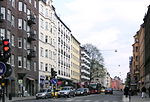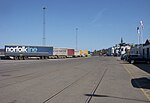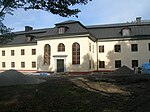Spårvägsmuseet
1944 establishments in SwedenMuseums established in 1944Museums in StockholmRailway museums in SwedenTechnology museums

The Spårvägsmuseet, or Tramway Museum, was located at Tegelviksgatan 22 in Södermalm, Stockholm, Sweden. It was owned and operated by Storstockholms Lokaltrafik (the Greater Stockholm Local Transit Company), and shows the development of public transportation in the Stockholm area from the 1650s until today. The Museum's mission also covers contemporary and future public transport in the Stockholm region, and water transportation in the area. The museum also houses a library, an archive and a café. The museum closed to the public in September 2017 and reopened in May 2022 in a former gasworks building in the Hjorthagen neighbourhood.
Excerpt from the Wikipedia article Spårvägsmuseet (License: CC BY-SA 3.0, Authors, Images).Spårvägsmuseet
Tegelviksgatan, Stockholm Södermalm (Södermalms stadsdelsområde)
Geographical coordinates (GPS) Address Nearby Places Show on map
Geographical coordinates (GPS)
| Latitude | Longitude |
|---|---|
| N 59.311666666667 ° | E 18.098611111111 ° |
Address
Mandelparken
Tegelviksgatan
116 41 Stockholm, Södermalm (Södermalms stadsdelsområde)
Sweden
Open on Google Maps











